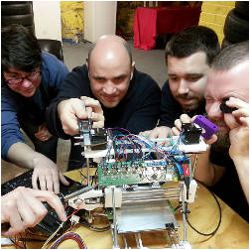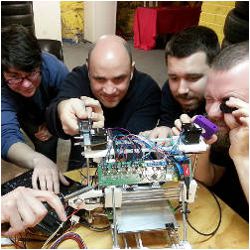
Hacker spaces, communal areas where people use shared tools to build whatever toy, craft, or gadget strikes their fancy, have been growing in popularity around the world. The hackerspaces.orgwiki listed more than 1,400 such locations as of mid-May. Governments from the U.S. to China are providing funding to promote their growth, and that has provoked discussion over the evolving nature of the spaces and how they should be conceived.
The spaces go by various names—hacker spaces, maker spaces, tech shops, fab labs—but generally consist of a collection of manufacturing equipment such as laser cutters, 3D printers, and computer numerical control (CNC) systems that perform computer-aided manufacturing, as well as more old-fashioned tools such as oscilloscopes and welding equipment, plus raw materials. They generally offer courses on how to use the equipment, and provide staff to help. Users pay a membership fee or a single-use fee to get access to the space and the equipment. Projects can range from arts and crafts to electronic gadgetry to robots, all dictated by the whims of the users.
Dale Dougherty, the founding editor and publisher of Make magazine and co-founder, in 2006, of the Maker Faire, which brings engineers and artists to show off their creations, makes distinctions between the different types of spaces.
Fab labs, he says, tend to be associated with universities and have academic aims; they were originally created at the Massachusetts Institute of Technology’s Media Lab.
Tech shops may be more commercial, while maker spaces are open to do-it-yourselfers of varied backgrounds and ages.
Hackers—computing and engineering types who like to explore how things work and try to make them better—are only a subset of the maker movement, Dougherty says. “There’s a lot broader range of participation than just hackers,” he says.
Dougherty makes the analogy with public gyms, spaces that provide shared exercise equipment. Once they were limited to bodybuilders, who organized them for their own purposes; now they attract members of the general public, who have various workout goals and fitness levels, but who all have a common aim of getting exercise.
Yet with evolution and increased interest can come controversy. Early last year, Dougherty, then with O’Reilly Media’s Make Division, won a grant from the U.S. Defense Advanced Research Projects Agency (DARPA) to fund its Makerspace project, developed along with Otherlab, a research and development company in San Francisco. The goal of the program, funded by DARPA’s Manufacturing Experimentation and Outreach (MENTOR) program, is to introduce high school students to various manufacturing tools they can use to build projects from mobile robots to go-karts. DARPA plans to provide $10 million to 1,000 schools over three years to promote science, technology, engineering, and mathematics (STEM) education.
O’Reilly’s involvement led some hackers to boycott the Maker Faire. One of the chief critics is Mitch Altman, co-founder of the San Francisco hacker space Noisebridge, who worries that DARPA will steer work in spaces it funds toward military applications, uses he does not want his efforts supporting. “I see the military as going out and bombing and killing, not for defending our country but for other purposes,” he says.
Even though the U.S. Defense Department says the DARPA funding comes with no strings, Altman does not believe that. “When a politician accepts gifts from individuals and corporations, it’s very likely going to be perceived that they’re taking a bribe and they’re going to have to pay it back,” he says. “It does change what we’re willing to do and not do for the sake of the money.”
Tim O’Reilly, founder of O’Reilly Media and a supporter of the open source movement, thinks those who believe they can avoid entanglements with military funders are being naïve. After all, the Internet originated with DARPA’s predecessor, the Advanced Research Projects Agency, and global positioning satellites were initially launched for military uses. O’Reilly says those who so vocally oppose contributions that are in any way Defense-related still are “perfectly happy to use the GPS in their phone for things like maps and Foursquare.” He thinks having more funding, and reaching more people, will only benefit the maker movement. “If anything, the government money will help create more do-it-yourself opportunities.”
Altman responds that, although the government may have created the Internet for military purposes, it was hackers who turned it into something that could benefit society. “Once it existed, hackers took it and improved upon it and shared it,” he says. “That’s what hackers do. That’s the whole ethos.”
He does not oppose all government funding; Altman would accept a Department of Education grant if it aligned with his values and did not come with constraints he disliked. He respects Dougherty and others who disagree with his stance, but he hopes that people take ethics into consideration when accepting funding, whatever the source. “If people look at it differently, hopefully they’re looking at it consciously.”
High Ideals
One area where O’Reilly and Altman agree is regarding the potential for the hacker ethos to be a force for good. O’Reilly, for instance, recently contributed to a Kickstarter campaign to start community hacker spaces in Baghdad, Iraq. Aside from helping to spur individual creativity, such spaces may help the Iraqi people see Americans as something other than invaders, he says. “I’d like to see the spirit of hackerdom improve peace in the Middle East,” says O’Reilly.
Indeed, the maker movement is spreading around the globe, often with support from governments. The city of Shanghai, for instance, announced in 2011 it would provide funding for 100 spaces it called “innovation houses.” A maker fair was held in April 2012 in the Chinese city of Shenzhen, and there are plans for a Beijing fair later this year, says Benjamin Koo, associate professor of industrial engineering at Tsinghua University in Beijing.
Koo ran a hackerthon at the university in January. Over the course of 80 straight hours, the 200 students participating had to react to a fictional disaster on an island, building a system that would deliver support to the island. The idea of such an “extreme learning process,” he says, is to force students, who in China are used to dutifully taking in what is presented to them in class, to move out of their comfort zone and discover their capabilities. “For the first time in their lives, they became masters of their own time,” Koo says. His hope is to change the way universities and students in China—and elsewhere in the world—approach education, and it is a change the government supports, hoping to modernize China’s economic role, he says.
“China is obviously capable of producing goods, but is really set up in a mentality similar to the 1800s and 1900s, that humans are basically instruments making these products,” Koo says. He hopes the maker model can help transform the Chinese into inventors and entrepreneurs.
Crossing Continents
International cooperation is a theme among makers. Koo is applying for grants that would allow some of Altman’s colleagues to live and work at Tsinghua for two to three months in a hackers-in-residence program. He is also the founder of the Toyhouse, a hacker space that is trying to help educators, technologists, entrepreneurs, artists, and government agencies share knowledge and ideas. “In order to have hacker spaces run successfully, you need to have official recognition as well as very professional organizers to run this,” Koo says.
The Santiago Makerspace in the capital city of Chile runs on corporate sponsorship from companies such as Microsoft and Nextel, membership fees, and roughly $250,000 from CORFU, the Chilean Economic Development Agency. Tiburcio de la Carcova, who runs the maker space, says part of the government funding is for the space itself, while part will go to support a maker fair later this year.
He organized Latin America’s first such fair, which ran in Santiago last December and drew more than 5,000 people. Many of the participants at the fair, and many of the people who take courses and do projects at Santiago Makerspace, are children ranging from elementary school age to teenagers. The hands-on, playful quality of the maker movement is helping to educate youngsters in electronics and engineering, among other disciplines, in ways traditional schooling has not, de la Carcova says.
The people involved in Santiago Makerspace did discuss what effect the funding sources would have on their mission. “That was one of the concerns—if we get the money from the sponsors, are we going to change?” he says. However, he explains, the government does not dictate their projects, and the members of the maker space are committed to their personal values. Those include openness—the group shies away from patents as potentially stifling innovation—and sustainability, with a strong commitment to recycling.
“I don’t think that funding, if you have a clear vision, can dictate what you will do,” de la Carcova says.
Further Reading
Lindtner, S. and Li, D
Created in China: the makings of China’s hackerspace community, ACM Interactions 19, 6 November 2012.
O’Leary, A.
Worries Over Defense Department Money for Hackerspaces, New York Times, Oct. 5, 2012.
Tweeny, D.
DIY Freaks Flock to “Hacker Spaces” Worldwide, Wired, March 29, 2009.
Merlo, S.
China’s First Maker Faire This Sunday in Shenzhen, Make, April 5, 2012.
Mota, C.
What We Can Learn from Hackerspaces, TedxTalks, http://www.youtube.com/watch?v=2c_8tsbRF8g
Santiago Mini Maker Faire Day 1 http://vimeo.com/55749953





Join the Discussion (0)
Become a Member or Sign In to Post a Comment